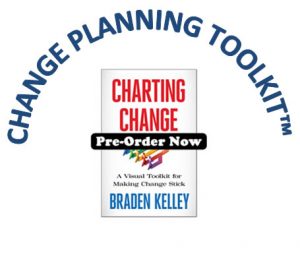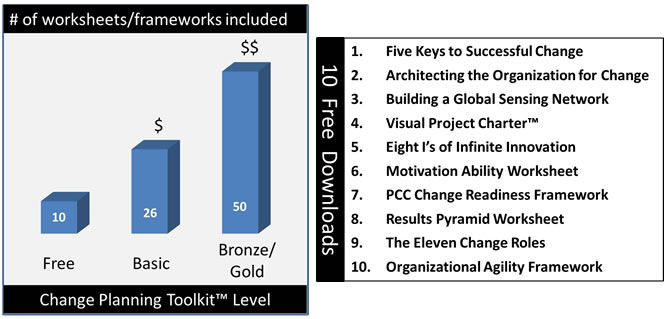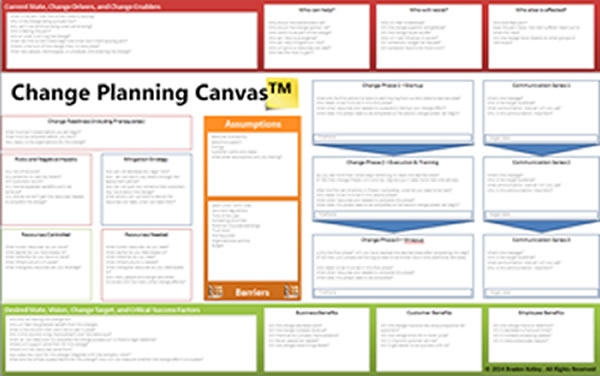 The Change Planning Toolkit™ is finally here!
The Change Planning Toolkit™ is finally here!
Following the success of Stoking Your Innovation Bonfire, it has become abundantly clear in my work with clients that for any organization to be good at innovation they must be good at change.
Not surprisingly, research shows that 70% of change efforts fail. There are many reasons why, including that many people find the planning of a change effort overwhelming and lack tools for making the process more visual, collaborative and human.
Putting my two decades of research together with my project management and change leadership experience with clients, I have distilled key insights into the Human-Centered Change™ methodology and captured it in a new book Charting Change (Feb 2016) and a suite of tools to help get everyone literally on the same page for change.
 I am making 10 Free Human-Centered Change™ Tools from the toolkit available as 11″x17″ samples, I am making 10 Free Human-Centered Change™ Tools from the toolkit available as 11″x17″ samples, |
 but book buyers will get access to the Change Planning Toolkit™ Basic License (26 of 50+ tools) at 11″x17″ size — a $500 value, but book buyers will get access to the Change Planning Toolkit™ Basic License (26 of 50+ tools) at 11″x17″ size — a $500 value, |
 and buyers of the Change Planning Toolkit™ Bronze License will get access to all 50+ tools for individual educational use at an 11″x17″ size — a $1,200 value. and buyers of the Change Planning Toolkit™ Bronze License will get access to all 50+ tools for individual educational use at an 11″x17″ size — a $1,200 value. |
 Site licenses are available for professional or commercial use starting at $2/yr per employee*, and include access to poster size versions of many of the tools (35″x56″), along with public or private training sessions. Click here for more information and pricing.
Site licenses are available for professional or commercial use starting at $2/yr per employee*, and include access to poster size versions of many of the tools (35″x56″), along with public or private training sessions. Click here for more information and pricing.
I am very excited to share with you the Change Planning Toolkit™, including the popular Visual Project Charter™, Change Planning Canvas™ and many other great tools for increasing your change success!
Increase your consulting revenue or your organizational agility and get a jump on your competition!
Click here to access the Human-Centered Change™ tools
*Bronze Site Licenses have a one-time setup fee of $299. Site License fee based on total number of employees in the organization.
Below you’ll find a downloadable presentation that gives you five reasons to invest in the Change Planning Toolkit™ in case you need help convincing your boss to let you make the nominal expenditure or to fund a site license or private event to train you and your team and trainers.
![]() Sign up here to get Human-Centered Change & Innovation Weekly delivered to your inbox every week.
Sign up here to get Human-Centered Change & Innovation Weekly delivered to your inbox every week.
Change Resistance is Not Inevitable
 The idea that people always resist change is a lie, and it is extremely damaging to organization’s seeking to increase their organizational agility.
The idea that people always resist change is a lie, and it is extremely damaging to organization’s seeking to increase their organizational agility.
The truth is that people only resist changes that they either do not understand or for which they do not interpret there to be benefits great enough to offset the costs of their participation.
The truth is also that the natural response to a potential change in an organization is greatly impacted by the level of trust in an organization.
While it is a lie that change resistance is inevitable, it is true that executing change is hard. If it wasn’t, 70 percent of change efforts wouldn’t fail, but they do. There are many reasons for this, including the fact that most change efforts are communicated not explained.
Let’s look at definitions of both words from Dictionary.com to see the root of this difference:
Communication: A document or message imparting news, views, information, etc.
Explanation: A mutual declaration of the meaning of words spoken, actions, motives, etc., with a view to adjusting a misunderstanding or reconciling differences
You’ll notice here a big difference between the two mindsets – seeking to communicate versus seeking to explain. When you focus on explaining the change, you are focusing on ensuring UNDERSTANDING, and when people understand the change, and the purpose for the change they will be more likely to support the change.
We don’t resist change, WE RESIST THAT WHICH WE DON’T UNDERSTAND.
One great way for increasing your ability to explain change is the use of a tool like the Change Planning Canvas™ to involve more people in the planning of a change, which increases the number of people capable of explaining the change and its purpose, plus it provides a visual map of the change effort that explains the change at a glance.
This is not say that even when people completely understand a potential change and the purpose for it, that they still might not not fight against it, but they will be more likely to support the change.
.
.
The Change Planning Canvas™ is one of the more than fifty tools that make up my new Change Planning Toolkit™ that is now available via individual licenses for educational use and site licenses for professional and commercial use. It helps you move away from the incredibly counter-productive practice of planning change in isolation.
Organizations that do a better job of explaining their changes and the purposes for them, not coincidentally also tend to build up a higher level of trust over time, and organizations that do a better job at change explanation and maintain higher levels of trust are able to change faster!
But some people may still resist, why?
Some people may resist your change effort for a number of different reasons, but you need to identify up-front not only why people resist but also who will likely resist. Change Planning Toolkit™ users will want to capture the group’s thoughts on who will resist in the middle box of the People Worksheet from the toolkit and the corresponding box on the Change Planning Canvas™.
Some of the typical reasons why people will resist include:
- inability to see the need for change or relevance;
- loss of certainty (includes fear of job loss);
- loss of purpose, direction, or status;
- loss of mastery (includes loss of expertise/recognition);
- loss of control or ownership;
- loss of connection or attachment;
- lack of trust or clarity;
- fear of failure (feel unprepared);
- see proposed change as irrelevant or a bad idea;
- feel overwhelmed by thought of change.
You’ll want to identify the individuals or groups who have one of the above reasons for resisting change, and you will want to plan from the start to overcome that resistance in the same way that any good salesperson plans for objections, learns to hear them, and practices how to overcome them (for example, by developing and sharing strategies with coworkers).
.
.
In the Change Planning Toolkit™ I’ve provided space in the Overcoming Resistance Worksheet for your team to brainstorm both the groups and individuals likely to feel any of these reasons for resistance, together with space to capture some ideas for overcoming these objections (aka resistance).
The Change Planning Toolkit™ also provides the Five Change Reactions Worksheet which allows you to identify which groups and individuals tend towards each of the five change reactions highlighted in this worksheet and explained in my book Charting Change.. These five change reactions typically occur in a standard distribution (aka bell curve) and you can increase the chances of your change success by shifting enough people to the left along the curve.
So, there you have it, a quick look at The Big Change Management Lie about the inevitability of change resistance and some ways that it can be avoided or at least mitigated, and an introduction to how some of the tools from the Change Planning Toolkit™ can provide even more help.
![]() Sign up here to get Human-Centered Change & Innovation Weekly delivered to your inbox every week.
Sign up here to get Human-Centered Change & Innovation Weekly delivered to your inbox every week.



